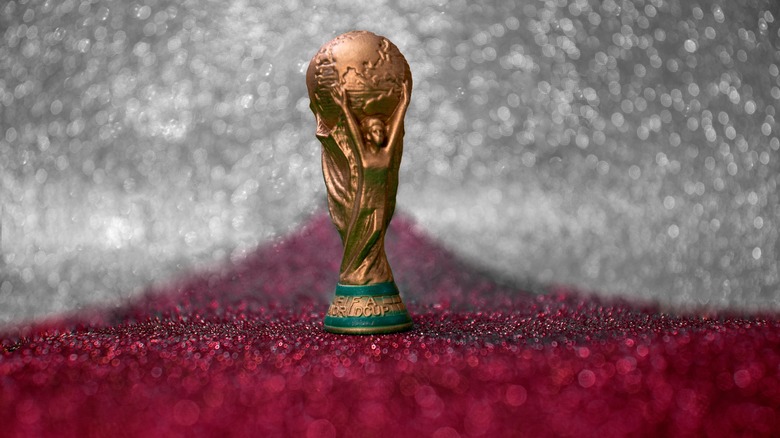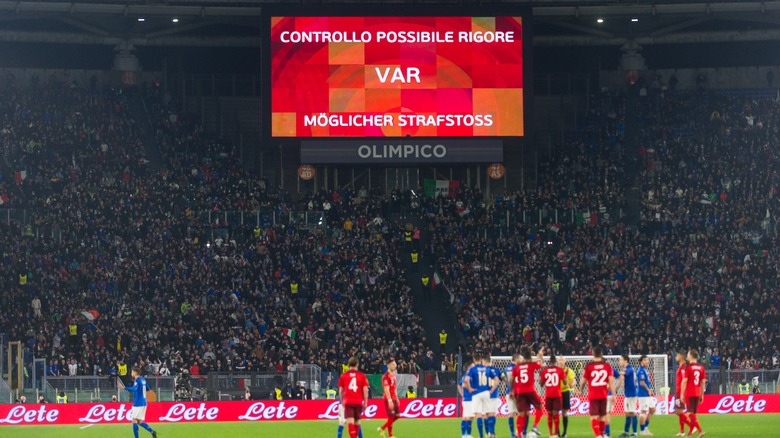AI Is Calling The Shots At The 2022 FIFA World Cup
Technology is set to play a huge part in the outcome of this winter's FIFA World Cup. The tournament, which is being held in Qatar, will be the first to use AI technology to assist officials in making game-changing calls. FIFA says the new technology will mainly focus on helping officials correctly judge offside calls. A correct or incorrect offside call could mean the difference between a goal or major incident standing or not — drastically altering the outcome of a match.
Offside calls were the subject of controversy long before technology entered the game. During the 2002 World Cup, Spain was eliminated by South Korea after a number of controversial offside calls, along with other decisions, led to the hosts winning 5-3 on penalties. A non-off-side related controversy in 2010 led to England being eliminated by Germany. A Frank Lampard goal that would have leveled the game 2-2 was not counted, despite the ball clearly crossing the line. These incidents convinced global footballing authorities to look at ways in which technology could help make decisions clearer and take pressure off officials.
Before the controversies stacked up, major footballing bodies like FIFA had resisted implementing technology. They had instead insisted on the referee's word being final and harshly punished any criticism of an official's decisions. This policy included a ban on replays of incidents within stadiums, because showing several thousand people how blatantly wrong a referee's call was right after it happened may not be the best thing for the referee's confidence or the fans' mood.
For reference, the offside rule has many factors — but at its most basic level, it requires two defending players to be between the goal and the attacker receiving the ball when another attacker plays the ball to them.
VAR has been quite controversial
In 2016, the International Football Association Board allowed a trial run of the video referee system, which would eventually be known as VAR. The video technology was only to be used in cases where a "clear error" had been made — such as the referee missing a major incident, or a goal being scored that should not have stood. The video technology was also supplemented by things like sensors within the balls that would alert the referee when it had crossed the goal line. VAR eventually made its way to top divisions like The Premier League, and to major tournaments like the 2018 World Cup. However, instead of solving the game's issues, the introduction of technology has been the target of criticism from fans.
Communication issues were flagged as a major problem, as fans inside the stadium saw decisions overturned seemingly without reason. Strangely, it has also been blamed for not allowing fans to really enjoy goals like they used to. As the tech is capable of spotting things like an offside by a far smaller margin than a linesman could, there have mean more frequent and closer calls since it was implemented. Therefore, rather than celebrating when the ball hits the net, some sets of fans have been waiting nervously for a VAR check to go through before they cheer, which takes a bit of the excitement away.
However, as Manchester Metropolitan University notes, the majority of fans acknowledge VAR is a part of the game now and would rather improve the technology than remove it completely. Hopefully, FIFA's new AI system is a step towards that.
How FIFA will use AI to accurately track players
Following the 2018 World Cup, football's governing body committed to striving "to harness the full potential of technology in football and further enhance VAR." Cutting-edge AI tracking seems to be a large part of that. According to FIFA, a sensor will be placed in the center of each ball used allowing officials to track it up to ten times more precisely than they can with other methods — like in the use of broadcast footage. There are also 12 tracking cameras in the stadium which will follow 29 points on each player's body. Player points will be tracked 50 times per second, while the ball sends out a signal 500 times per second — allowing officials to judge the exact moment it is played.
The technology working together will provide "an automated offside alert to the video match officials inside the video operation room whenever the ball is received by an attacker who was in an offside position at the moment the ball was played by a team-mate." That call will then be forwarded to the on-field referee.
FIFA President Gianni Infantino described the technology as: "the culmination of three years of dedicated research and testing," before adding: "FIFA is committed to harnessing technology to improve the game of football at all levels, and the use of semi-automated offside technology at the FIFA World Cup in 2022 is the clearest possible evidence."
In terms of accuracy, due to the speed that the game is played at, a single frame can make the difference between a player being offside and a player being onside. An issue the far more accurate AI-based system should be able to fix.

